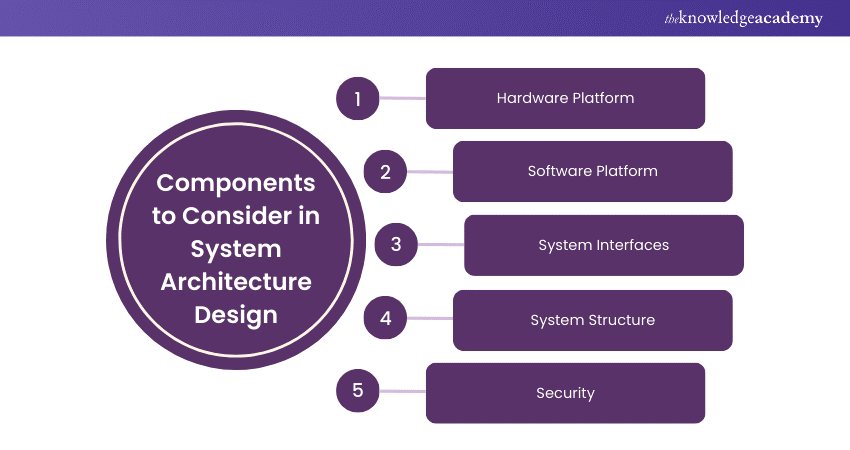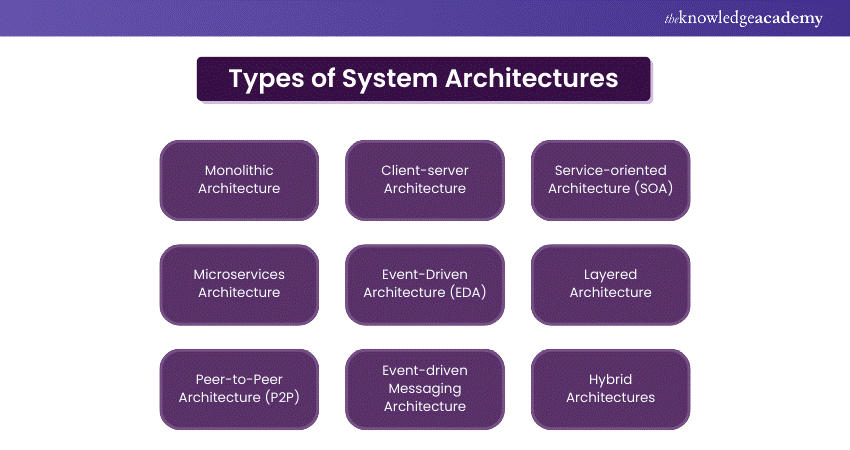We may not have the course you’re looking for. If you enquire or give us a call on +44 1344 203999 and speak to our training experts, we may still be able to help with your training requirements.
Training Outcomes Within Your Budget!
We ensure quality, budget-alignment, and timely delivery by our expert instructors.

Are you curious about how complex systems work together so effortlessly? System Architecture is like the master plan that outlines how each part of a system collaborates to create a harmonious and efficient operation. In this blog, we discuss the essential components of System Architecture and explore various types, such as monolithic and microservices, to help you find the perfect fit for your needs.
Whether you’re a beginner or a tech enthusiast, this blog shows you how smart architecture can enhance performance, security, and scalability. Dive in to discover the world of System Architecture!
Table of Contents
1) What is System Architecture?
2) Components to Consider When Designing a System Architecture
3) Types of System Architectures
4) Benefits of Using System Architecture
5) Conclusion
What is System Architecture?
System Architecture is the conceptual model that defines the structure, behaviour, and views of a system. It provides a comprehensive blueprint that outlines how different components of a system interact and work together to achieve specific objectives.
System Architecture is essential for ensuring that all parts of a system align with the overall goals and requirements. It encompasses both hardware and software components, system interfaces, and security considerations.
Components to Consider When Designing a System Architecture
When designing a System Architecture, several key components must be considered to ensure the system functions smoothly and efficiently. These components form the backbone of the architecture and influence its performance and scalability. Let’s explore:

Hardware Platform
The hardware platform is the physical foundation of a system. It includes servers, storage devices, network equipment, and other hardware components. When choosing hardware, it's essential to consider factors such as processing power, storage, and network connectivity. The hardware platform should be scalable to accommodate future growth and advancements in technology.
Software Platform
The software platform includes the operating systems, applications, and other software components that run on the hardware. Selecting the right software platform is crucial for achieving optimal performance and compatibility. It should support the system's functionality and be adaptable to changing needs and technological advancements.
System Interfaces
System interfaces define how different components of a system communicate with each other. They include Application Programming Interfaces (APIs), protocols, and data formats. Well-designed interfaces ensure seamless communication between components and enable interoperability with external systems. Clear and standardised interfaces reduce the risk of errors and enhance system flexibility.
System Structure
The system structure outlines the organisation and arrangement of components within the system. It determines how data flows, how processes are executed, and how components interact. A well-structured system ensures efficient resource utilisations and simplifies maintenance and troubleshooting. System Architects must carefully design the structure to achieve optimal performance and reliability.
Security
Security is a critical component of System Architecture. It involves protecting the system from unauthorised access, data breaches, and other threats. Security measures include authentication, encryption, access controls, and intrusion detection systems. A robust security framework ensures that sensitive data is safeguarded and that the system remains resilient against cyberattacks.
Learn ways to choose a programming language with our Software Design and Architecture Training – Join today!
Types of System Architectures
System Architectures can be classified into various types, each with its own characteristics and use cases. Here are some of them:

Monolithic Architecture
It is a traditional approach where all components of a system are tightly integrated into a single unit. In a monolithic system, all functions are interdependent, and changes to one part can affect the entire system. While monolithic architecture is simple to develop and deploy, it can become challenging to maintain and scale as the system grows.
Example: Many legacy applications and early software systems are built on monolithic architecture.
Client-server Architecture
Client-server architecture is a distributed model where the system is divided into clients and servers. Clients request services from servers, which process the requests and return responses. This architecture allows for centraliseds control and efficient resource allocation. It's often used in web applications, where the internet browser is the client, and the server runs the application.
Example: Email services, where the email client interacts with the email server.
Servic-oriented Architecture (SOA)
Service-oriented Architecture (SOA) is a modular approach that organises a system as a collection of services. Each service is a self-contained unit that performs a function and communicates with other services through interfaces. SOA promotes reusability and scalability, making it suitable for complex and evolving systems.
Example: A banking system where different services handle Account Management, transaction processing, and customer support.
Microservices Architecture
Microservices architecture is an evolution of SOA, where a system is composed of small, independently deployable services. It is responsible for a specific functionality and can be developed, tested, and deployed independently. This architecture enhances agility and scalability, allowing organisations to quickly adapt to changing requirements.
Example: E-commerce platforms, where separate microservices manage product catalogues, orders, and payments.
Event-driven Architecture (EDA)
It is a design pattern that focuses on responding to events or changes in the system. Components within an EDA system communicate through event notifications, enabling real-time processing and decision-making. This architecture is well-suited for systems that require rapid responses to dynamic conditions.
Example: Stock trading platforms that react to market changes in real time.
Layered Architecture
Layered architecture organises a system into layers, each with a specific responsibility. Common layers include presentation, business logic, data access, and database layers. This architecture promotes the separation of concerns and simplifies maintenance by isolating changes to specific layers.
Example: Web applications that separate user interfaces, application logic, and Data Management.
Peer-to-Peer Architecture (P2P)
Peer-to-Peer (P2P) architecture is a decentraliseds model where each node in the system acts as both a client and a server. Nodes can share resources and communicate directly with each other without relying on a central server. P2P architecture is resilient and scalable, making it suitable for distributed systems.
Example: File-sharing networks like BitTorrent, where users share files directly with one another.
Event-driven Messaging Architecture
Event-driven messaging architecture combines elements of EDA and messaging systems to enable asynchronous communication between components. Messages are sent and processed based on events, allowing for flexible and scalable system interactions. This architecture is ideal for systems with high concurrency requirements.
Example: Notification systems that send alerts based on specific triggers.
Hybrid Architectures
Hybrid architectures combine elements of multiple architectural styles to create a customised solution. This approach allows System Architects to leverage the strengths of different architectures and address specific challenges. Hybrid architectures offer flexibility and adaptability for diverse use cases.
Example: A social media platform that uses microservices for content delivery and a layered architecture for user authentication.
Benefits of Using System Architecture
Implementing a well-defined System Architecture offers numerous benefits:
a) Improved Performance: A clear architecture ensures efficient resource allocation and optimal system performance.
b) Scalability: Properly designed architectures accommodate future growth and evolving user needs.
c) Maintainability: Modular architectures simplify maintenance and troubleshooting, reducing downtime and costs.
d) Security: A robust architecture includes security measures that protect against threats and vulnerabilities.
e) Flexibility: Adaptable architectures allow for easy integration of new features and technologies.
f) Collaboration: A shared architectural framework promotes collaboration among development teams and stakeholders.
Learn design techniques with our Systems Development Essentials Training – Join today!
Conclusion
System Architecture is the backbone of any complex system, guiding its design, implementation, and operation. By understanding the components and types of System Architectures, organisations can make informed decisions to meet their specific needs and objectives. Embracing the right architectural approach will empower you to develop innovative solutions that drive success in today’s technological landscape.
Learn how to implement a Change Management plan with our Software Development Lifecycle Training – Join today!
Frequently Asked Questions

To get good at System Architecture, start by learning the basics of different architectures and their components. Practice designing systems, study real-world examples, and keep up with the latest technology trends to sharpen your skills.

System Architecture is the overall blueprint that outlines the structure and components of a system, focusing on how everything fits together. System design is more detailed and involves planning the specific components and processes needed to implement the architecture effectively.

The Knowledge Academy takes global learning to new heights, offering over 30,000 online courses across 490+ locations in 220 countries. This expansive reach ensures accessibility and convenience for learners worldwide.
Alongside our diverse Online Course Catalogue, encompassing 17 major categories, we go the extra mile by providing a plethora of free educational Online Resources like News updates, Blogs, videos, webinars, and interview questions. Tailoring learning experiences further, professionals can maximise value with customisable Course Bundles of TKA.

The Knowledge Academy’s Knowledge Pass, a prepaid voucher, adds another layer of flexibility, allowing course bookings over a 12-month period. Join us on a journey where education knows no bounds.

The Knowledge Academy offers various Software Engineering Courses, including Software Design and Architecture Training, Systems Development Essentials Training, Software Development Lifecycle Training. These courses cater to different skill levels, providing comprehensive insights into Web Development.
Our Programming & DevOps Blogs cover a range of topics related to Software Design and Architecture, offering valuable resources, best practices, and industry insights. Whether you are a beginner or looking to advance your skills in Software Design and Architecture, The Knowledge Academy's diverse courses and informative blogs have you covered.
Upcoming Programming & DevOps Resources Batches & Dates
Date
 Systems Engineering Training
Systems Engineering Training
Fri 3rd Jan 2025
Fri 28th Mar 2025
Fri 23rd May 2025
Fri 4th Jul 2025
Fri 5th Sep 2025
Fri 24th Oct 2025







 Top Rated Course
Top Rated Course



 If you wish to make any changes to your course, please
If you wish to make any changes to your course, please


